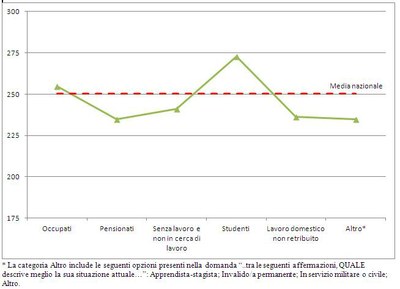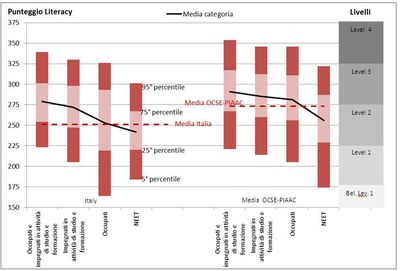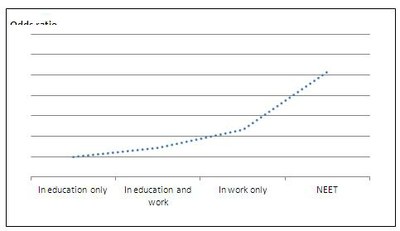PIAAC survey results highlight workers and students (if busy in full-time study activities) as the two types of status ensuring the highest skill levels. From a cultural point of view the weakest individuals are retired people, those who carry out unpaid household work, and those who do not have a job and are not looking for one.
Average score of adults aged 16-65 on the literacy skill scale per self-declared employment status

In particular, Italian NEETs (Not Education, Employment or Training) aged between 16 and 29 are the category with the lowest performance in terms of literacy skills: the average score reached by NEETs aged 16-29 is equal to 242, below the national average (average score 250).
When comparing the performance of NEETs aged 16-29 to their peers employed and/or involved in education and training activities the NEETs disadvantage is even more striking: only 5% of the latter reach level 3, while this same level is achieved by 25% of workers and 50% of those working and studying or those just studying. Furthermore, as shown by the extremely flat line representing Italian NEETs, there is not much variability between top and bottom performers, differently from workers’ rankings, with the lowest 5% placed at “Below level 1” while the highest 5% reached level 4.
Comparison Italy/OCSE average among average scores at 5th, 25th, 75th and 95th percentile NEET-other types of status in the 16-29 age bracket on the literacy skill scale.

PIAAC survey results allow us to assess retrospectively the risk of ranking at the lowest skill levels (Level 2 or below) by investigating the relationship between a control group and the skills identified. In particular, the PIAAC survey clearly shows a very strong link between participation in the labour or education world and the skills identified. NEETs aged between 16 and 24 actually report a systematic disadvantage at acquiring and maintaining skills: compared to peers involved in study activities or undergoing training, NEETs are much more likely (5 times as much) to rank at level 2 or below on the literacy skill scale.
Likelihood for young Italians aged 16-24 to reach Level 2 or below in the literacy skill scale according to their participation in the labour or education world [1]

Compared to those who undergo education and training activities, NEETs as well as those who work but do not undergo education and training programmes, and young people who work and study at the same time, may have higher chances to reach low scores.
[1] Odds ratio (OR) is a measure of the likelihood that a given event will occur for a special group as against a control group. An odds ratio equal to 1 means no variation for the special group as against the control group. An OR value less than 1 indicates lower odds that the given event will occur for a special group as against the control group, and an OR greater than 1 indicates higher odds that a given event will occur for the special group as against the control group. Odds ratios are measured by gender, age, parents’ level of education, immigration status.
Overview and data processing by Simona Mineo